Did you know that Belarus, a landlocked country in Eastern Europe, is home to an astonishing array of sacred natural sites and diverse wildlife? With natural complexes and ecosystems covering a staggering 65.8% of its territory, Belarus boasts two remarkable geo-botanical regions, the Eurasian taiga and European deciduous broad-leaved zones.
In terms of flora, Belarus is a haven for biodiversity, with approximately 12,000 plant species thriving within its borders. The country also hosts a multitude of fascinating fauna, including 467 species of vertebrates and over 30,000 species of invertebrates. From its swamps and forests to its kame moraines and lake complexes, Belarus is blessed with a natural heritage that is truly awe-inspiring.
Join us as we delve into the world of Belarusian nature conservation, exploring the efforts made to preserve sacred sites, protect wildlife, and promote sustainable development in this remarkable country.
Key Takeaways:
- Belarus is home to a wide range of sacred natural sites and diverse wildlife.
- Natural complexes and ecosystems cover a remarkable 65.8% of the country’s territory.
- The flora of Belarus boasts approximately 12,000 plant species.
- The country is home to 467 species of vertebrates and over 30,000 species of invertebrates.
- With swamps, forests, kame moraines, and lake complexes, Belarus possesses a unique natural heritage.
Status and Trends of Biodiversity
Belarus has made significant progress in biodiversity conservation through sustainable growth in its forest areas. The country has implemented state forestry regulations and achieved certification by the Forest Stewardship Council (FSC) and the Programme for the Endorsement of Forest Certification (PEFC) to ensure responsible forest management. This has led to the expansion of forest cover, promoting the preservation of diverse ecosystems and habitats.
However, there is an ongoing concern regarding the replacement of complex natural forests with mono-dominant forest species for economic purposes. While this monoculture may have short-term economic benefits, it threatens the long-term sustainability and resilience of the forests, as it reduces biodiversity and diminishes the ecological services provided by diverse ecosystems.
Belarus is home to a diverse range of plant and animal species, showcasing the country’s rich biodiversity. Some of these species are critically endangered, emphasizing the urgency of conservation efforts to protect their habitats and restore their populations.
Belarus recognizes the importance of biodiversity conservation and has taken significant steps to enhance the implementation of the Convention on Biological Diversity. The country has developed a comprehensive National Biodiversity Strategy and Action Plan (NBSAP) to guide conservation initiatives and ensure sustainable development for future generations.
As a part of its conservation efforts, Belarus has established a network of protected areas, including national parks and nature reserves. These protected areas play a crucial role in safeguarding biodiversity hotspots, preserving critical habitats, and promoting sustainable development.
Sustainable development is at the core of Belarus’ approach to biodiversity conservation. The country aims to balance economic growth with environmental protection, recognizing that maintaining healthy ecosystems is essential for the well-being of both natural resources and human communities.
Through sustainable practices and active preservation efforts, Belarus strives to secure a future where biodiversity thrives, ecosystems flourish, and the delicate balance between environmental conservation and human development is maintained.
Main Pressures on and Drivers of Change to Biodiversity
Biodiversity conservation in Belarus faces several key pressures and drivers of change that impact the country’s rich natural heritage. These include climate change, land use changes, pollution, habitat fragmentation, and forest damage caused by pests, diseases, hurricanes, and fires. These factors collectively contribute to the reduction of suitable habitats for plant and animal species, leading to a decline in biodiversity.
Climate change poses a significant threat to Belarus’ biodiversity, affecting temperature patterns, precipitation levels, and overall ecosystem functioning. As temperatures rise and rainfall patterns fluctuate, ecosystems may become susceptible to invasive species, altered species distribution, and changes in vegetation composition. These environmental shifts directly impact the survival and reproduction of plant and animal species.
Land use changes also play a major role in biodiversity loss within Belarus. Human activities such as deforestation, urbanization, and agriculture result in the conversion of natural habitats into fragmented landscapes, disrupting ecological balance. These changes lead to the displacement and loss of species, reduced habitat quality, and increased vulnerability to external pressures.
Pollution, including air and water pollution, pose additional threats to biodiversity in Belarus. The release of harmful chemicals and pollutants into the environment degrades natural habitats and negatively impacts the health and survival of plant and animal species. Pollution sources include industrial activities, agriculture, and improper waste disposal.
Fragmentation of habitats further compounds biodiversity loss in Belarus. The fragmentation of once contiguous habitats into smaller, isolated patches disrupts ecological connectivity, limiting species’ movements, genetic diversity, and the ability to adapt to changing environmental conditions. This fragmentation poses a significant challenge to the long-term survival and resilience of many species.
“Climate change, land use changes, pollution, habitat fragmentation, and forest damage caused by pests, diseases, hurricanes, and fires are all significant pressures impacting biodiversity in Belarus.”
Despite these challenges, Belarus has implemented several conservation projects to protect vulnerable species and their habitats. These projects employ strategies such as habitat restoration, species reintroduction, and the establishment of protected areas. Through these initiatives, Belarus has achieved successful recoveries and removals of certain species from threatened lists, improving overall biodiversity conservation efforts.
One such successful conservation project in Belarus is the restoration of wetlands and the preservation of endangered bird species. These efforts have led to the recovery of populations and the return of species that were once on the brink of extinction. By focusing on targeted conservation actions and collaboration with local communities, Belarus continues to make strides in safeguarding its natural heritage.
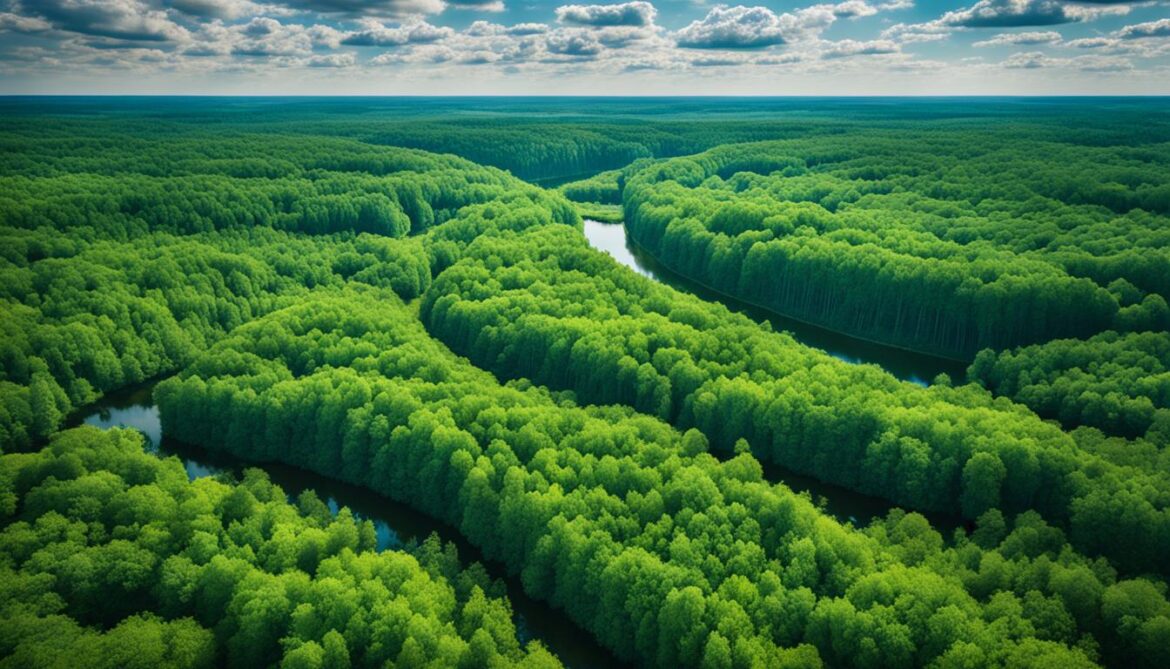
Measures to Enhance Implementation of the Convention
Belarus is committed to biodiversity conservation and has implemented the National Biodiversity Strategy and Action Plan (NBSAP) to prevent a decrease in species populations and diversity. The country has taken significant actions to achieve the 2020 Aichi Biodiversity Targets, including:
- Establishment of Protected Areas: Belarus has established a network of protected areas to safeguard crucial habitats and species. These areas play a vital role in preserving biodiversity and promoting sustainable development.
- Restoration of Broad-Leaved Forests: The restoration of broad-leaved forests is a key priority in Belarus. These forests support a diverse range of species and are essential for maintaining healthy ecosystems.
- Implementation of Landscape Conservation Projects: Belarus has implemented landscape conservation projects to protect and enhance biodiversity across different ecosystems. These projects aim to conserve and restore natural landscapes, improving the overall health of the environment.
Belarus recognizes the importance of international cooperation in biodiversity conservation. The country actively participates in international partnerships and has received funding from various donors to support its conservation projects.
To visually showcase Belarus’ efforts in biodiversity conservation, here is a table highlighting some key statistics:
| Effort |
Impact |
| Establishment of Protected Areas |
Preservation of critical habitats and species |
| Restoration of Broad-Leaved Forests |
Enhanced biodiversity and ecosystem health |
| Implementation of Landscape Conservation Projects |
Conservation and restoration of natural landscapes |
Through these measures, Belarus is making significant progress towards achieving its biodiversity conservation goals and contributing to the global efforts to protect and sustainably manage biological diversity.
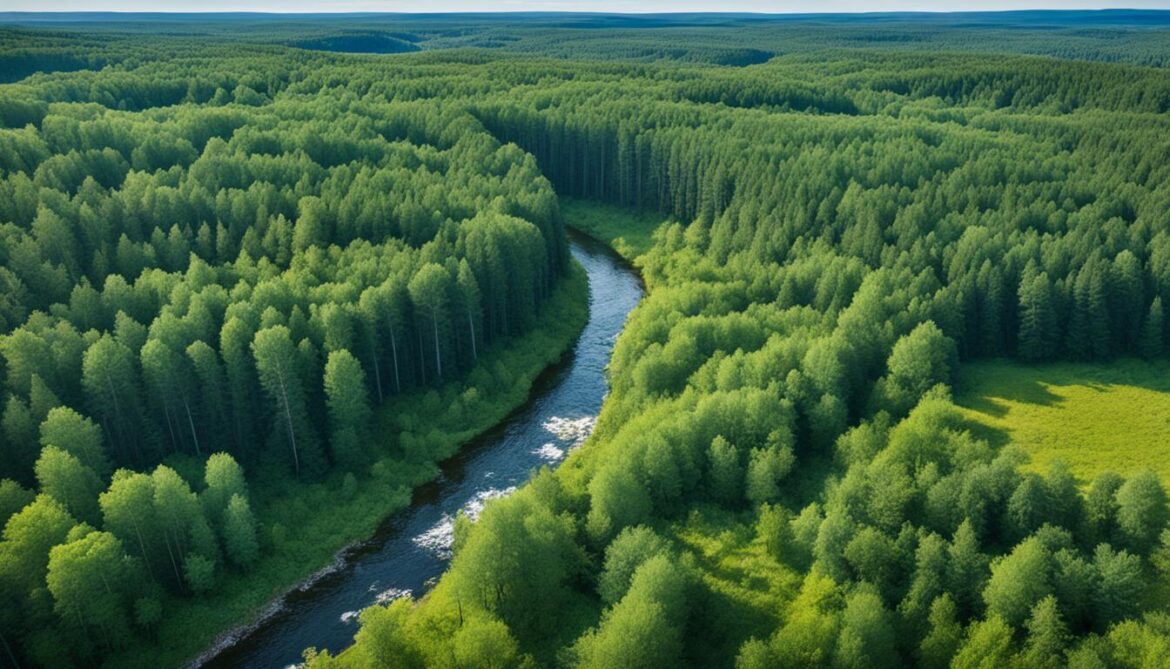
Actions Taken to Achieve the 2020 Aichi Biodiversity Targets
Belarus is taking significant actions to achieve the 2020 Aichi Biodiversity Targets and protect its rich natural heritage. The country has established a comprehensive system of protected areas, covering 7.7% of its total area.
These protected areas play a crucial role in conserving biodiversity and safeguarding important ecosystems. In addition to the designated protected areas, Belarus also has other natural sites subject to special protection, including water conservation zones. Together, these areas account for an impressive 22.1% of the country’s land, ensuring the conservation of diverse landscapes and species.
Furthermore, Belarus has implemented projects to restore and expand its broad-leaved forests. These initiatives focus on increasing the total forest area and restoring degraded forest ecosystems. By promoting sustainable forest management and conservation practices, Belarus is preserving vital habitats for a wide range of plant and animal species.
Conservation projects in Belarus have yielded positive results in protecting and restoring specific species. Notable successes include the conservation of the mute swan, European lynx, and aquatic warbler. Through targeted efforts, these species have been safeguarded and their populations have experienced significant recovery.
In addition to habitat conservation, Belarus has implemented measures to improve surface water quality and reduce the use of mineral fertilizers. These actions are vital to safeguard freshwater ecosystems and ensure the long-term well-being of aquatic species.
To summarize, Belarus’ proactive approach to achieving the 2020 Aichi Biodiversity Targets includes the establishment of protected areas, restoration of broad-leaved forests, species-specific conservation projects, and measures to improve water quality. These actions demonstrate Belarus’ commitment to preserving its natural heritage and promoting sustainable biodiversity conservation.

Key Achievements in Biodiversity Conservation in Belarus
| Protected Area |
Species Conserved |
Habitat Restored/Enhanced |
| Belavezhskaya Pushcha National Park |
European Bison, Lynx, Wild Boar |
Primeval Forest, Wetlands |
| Pravdinsky Reserve |
Aquatic Warbler, Great Snipe, Corncrake |
Meadows, Wetlands |
| Paliessie State Radiation and Ecological Reserve |
White Stork, Marsh Harrier, Beavers |
Marshes, Peatlands |
| Berezinski Biosphere Reserve |
Rare Orchids, Otters, Black Stork |
Rivers, Forests |
These achievements highlight Belarus’ commitment to conservation efforts and the successful outcomes of its biodiversity initiatives. By continuing to prioritize protected areas, habitat restoration, and species-specific conservation, Belarus is ensuring the long-term preservation of its unique landscapes and precious wildlife.
Vulnerabilities – Terrestrial Biodiversity
Climate change poses risks to terrestrial biodiversity in Belarus. One of the key vulnerabilities is the increased probability of mass breeding of forest pests, including Forest Pests Belarus. As temperatures rise, these pests can thrive and harm forest ecosystems, putting local plant and animal species at risk.
The expansion of forest-steppe and steppe flora into forest ecosystems is another concern. Climate Change Belarus is causing shifts in vegetation patterns, allowing steppe and forest-steppe species to encroach upon forests. This can disrupt the delicate balance of ecosystems and impact the biodiversity of the region.
Higher concentrations of CO2 in the atmosphere, a result of climate change, can lead to changes in species composition and increased plant productivity. While these changes may initially seem positive, they can have unexpected consequences on the overall ecosystem.
“Active shrub overgrowth of mires, although positive in terms of increasing forest resources, can lead to the loss of valuable wetlands and the species that depend on them.”
Forest resources may increase due to active shrub overgrowth of mires. However, this growth can come at the expense of valuable wetlands and the species that rely on them. It is essential to strike a balance between forest expansion and the protection of wetland habitats.
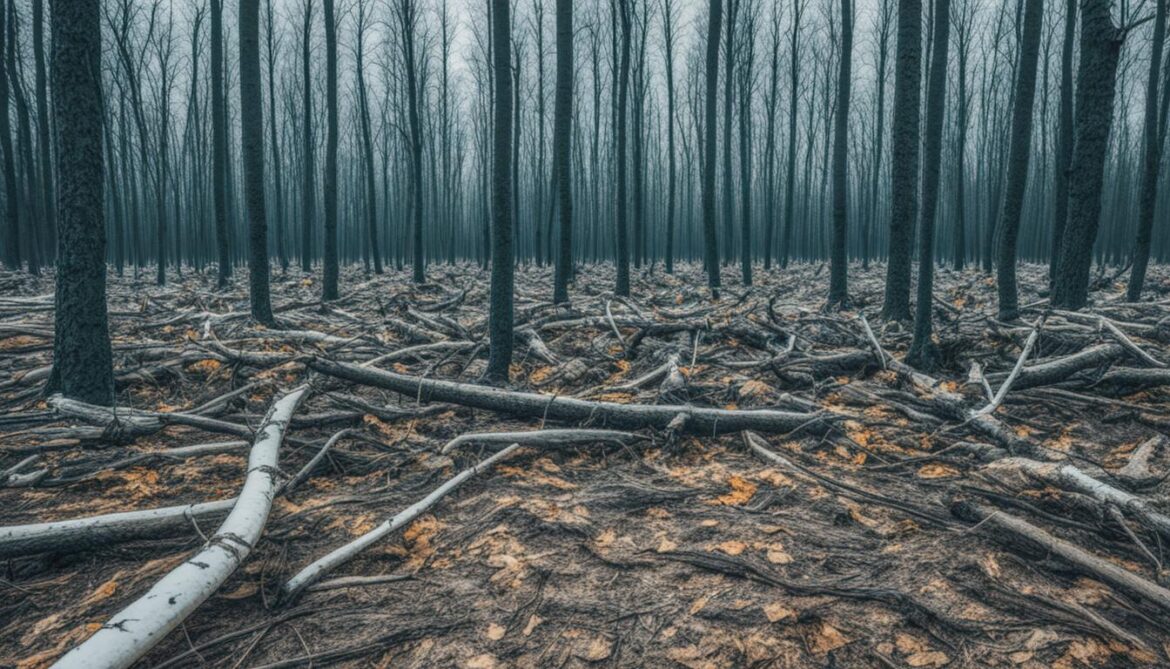
This image represents the potential impact of Forest Pests Belarus on terrestrial biodiversity. It serves as a reminder of the challenges faced in preserving the diverse ecosystems of Belarus.
Vulnerabilities – Fresh Water and Wetlands Biodiversity
Belarus is not immune to the vulnerabilities posed by climate change, which extend to its fresh water and wetlands biodiversity. These ecosystems play a crucial role in maintaining water quality and supporting diverse species.
Eutrophication and Water Quality
The increasing eutrophication of rivers and water reservoirs is a concerning consequence of climate change in Belarus. The excess nutrients from agricultural runoff and warmer temperatures promote the growth of harmful algae, negatively impacting the quality of drinking water. This poses significant challenges for both human consumption and the survival of aquatic species.
Impacts on Fish Stock
Rising water temperatures further compound the vulnerabilities of Belarus’ fresh water and wetlands biodiversity. As the temperatures increase, fish stock may experience weight loss and face an increased risk of mortality. This has a cascading effect on the entire aquatic ecosystem, disrupting the delicate balance of species and reducing biodiversity.
Radioisotope Concentrations
Additionally, climate change-induced water level fluctuations in rivers and lakes can result in increased concentrations of radioisotopes in surface water sources. Decreased water levels expose previously submerged sediments and release stored radioactive particles, leading to potential contamination. This poses a threat to both aquatic species and the safety of water resources.
“The conservation and protection of wetland ecosystems in Belarus are of utmost importance to maintain water quality and safeguard the country’s biodiversity.” – [Insert Name], Environmental Scientist
Efforts to preserve and restore wetland habitats are critical to mitigating these vulnerabilities and ensuring the long-term sustainability of the freshwater ecosystems in Belarus.
Adaptation Strategies
Peatlands in Belarus have undergone significant degradation due to drainage for agriculture, forestry, and peat extraction. The restoration efforts in Belarus are focused on rewetting the degraded peatlands, which contribute to climate regulation and store large amounts of CO2. The country has ambitious plans for large-scale peatland restoration, aiming to restore the ecological functions of these valuable ecosystems. By restoring and conserving peatlands, Belarus can help mitigate climate change and protect biodiversity.
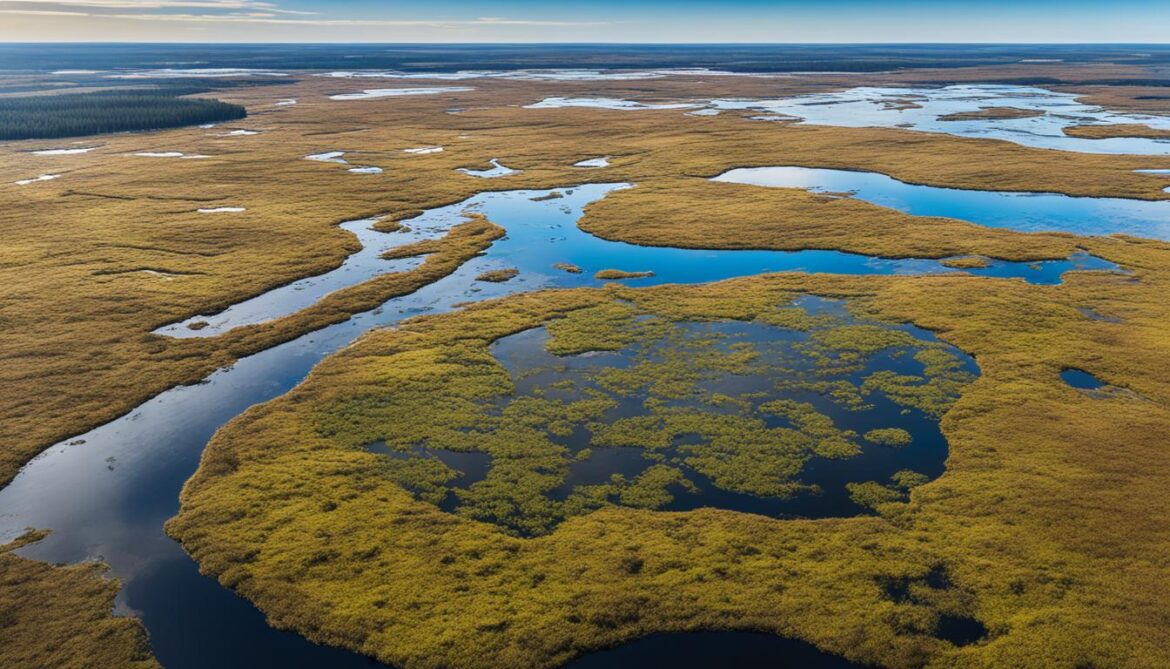
The restoration of degraded peatlands not only helps in carbon sequestration but also has many other environmental benefits. Healthy peatlands act as natural water filters, improving water quality. They provide vital habitats for a wide range of plant and animal species, including rare and endangered ones. Additionally, peatlands help to prevent flooding by absorbing and retaining water during heavy rainfall.
The experience gained from peatland restoration efforts in Belarus can serve as an important resource for other countries in the region facing similar challenges. Sharing knowledge and best practices can facilitate the implementation of effective restoration strategies and promote regional collaboration in conserving and restoring peatlands. International cooperation and knowledge exchange are essential in addressing global environmental issues, and Belarus is actively contributing to these efforts.
Benefits of Peatland Restoration
Restoring peatlands in Belarus brings numerous benefits, including:
- Enhanced carbon sequestration and climate regulation
- Improved water quality and water retention
- Preservation and restoration of biodiversity and habitats
- Prevention of soil erosion
- Protection against flooding
Restoring peatlands is a sustainable and effective approach to address environmental challenges and contribute to the conservation of biodiversity. With ongoing efforts and collaboration, Belarus is taking significant steps towards the restoration and protection of its valuable peatlands and their associated benefits.
Legislation and Funding for Biodiversity Conservation
Belarus is dedicated to upholding a well-established legislative framework for biodiversity conservation. The country has enacted laws to protect the environment, establish specially protected areas, and preserve the vegetable world. These legal measures ensure the sustainable management and conservation of Belarus’ unique and diverse ecosystems.
In order to support biodiversity conservation efforts, Belarus has received funding from various donors, including the United Nations Development Programme (UNDP), the Global Environment Facility (GEF), and the European Commission. This financial support enables Belarus to implement important conservation projects and initiatives that contribute to the preservation of the country’s natural heritage and wildlife.
Capacity-building, coordination, and mainstreaming efforts are also key aspects of Belarus’ approach to biodiversity conservation. By building the capacity of relevant institutions and stakeholders, Belarus ensures that conservation measures are effectively implemented and sustainable practices are adopted. Additionally, coordination among different sectors and organizations helps to maximize the impact of conservation initiatives and promotes collaboration in achieving common objectives.
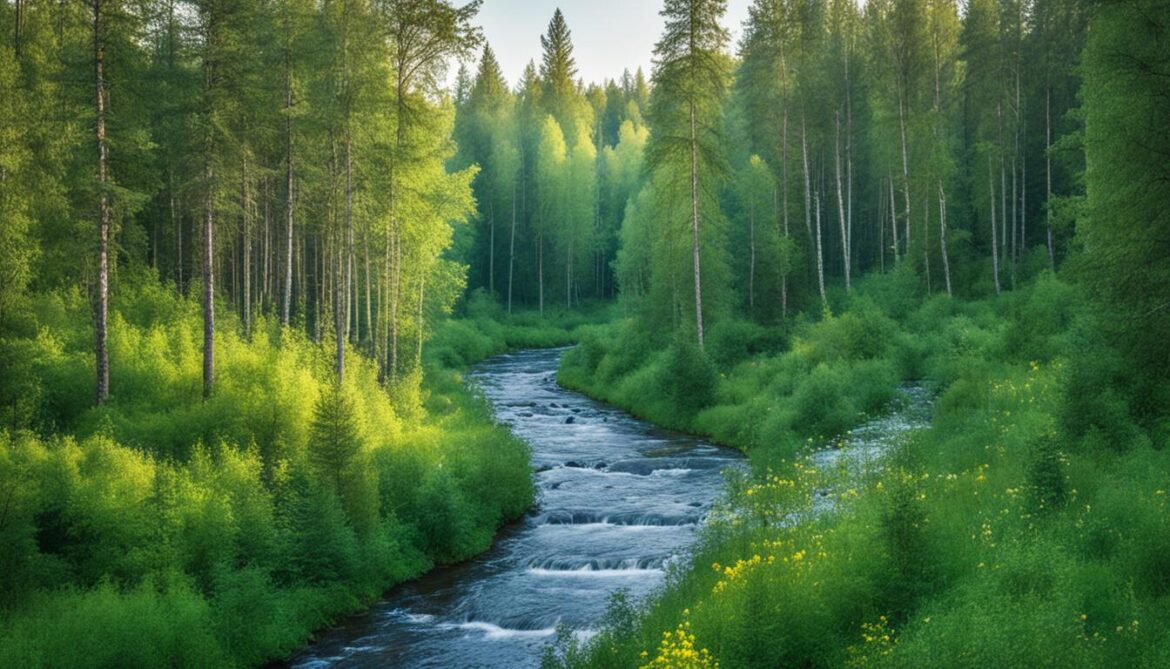
Belarus’ World Heritage Sites
Belarus takes great pride in its four World Heritage Sites, each offering a glimpse into the country’s rich history and natural wonders. These sites have been recognized and protected by UNESCO for their outstanding value to humanity.
1. Belovezhskaya Pushcha / Białowieża Forest
This transboundary site shared with Poland is a testament to the diverse and ancient primeval lowland forest that once covered most of Europe. Belovezhskaya Pushcha is one of the last and largest remaining parts of this extraordinary ecosystem, known for its pristine beauty and remarkable biodiversity.
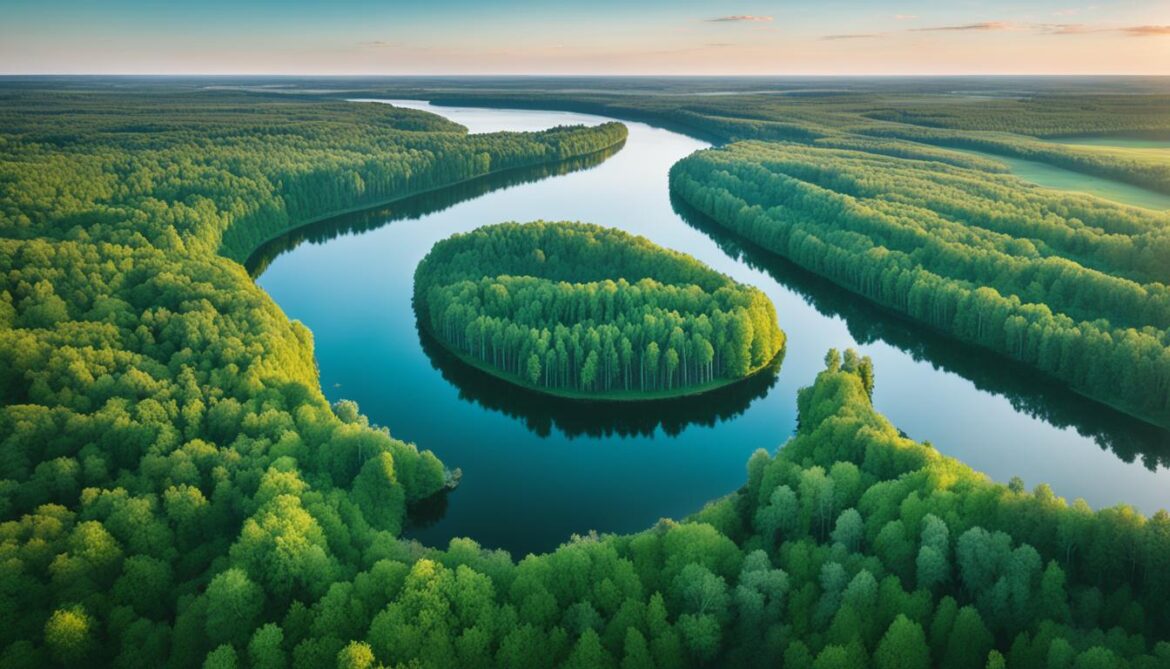
2. Mir Castle Complex
The Mir Castle Complex is a magnificent example of Gothic and Renaissance architecture. This medieval fortress has stood for centuries, serving as a residence for noble families and witnessing significant historical events. Visitors can explore the well-preserved castle with its elegant towers, stunning chambers, and picturesque gardens.
3. Architectural, Residential and Cultural Complex of the Radziwill Family at Nesvizh
The Nesvizh Castle complex is a masterpiece of architectural and artistic achievement. The palatial residence and its surrounding park are a testament to the wealth and cultural influence of the Radziwill family, one of the most powerful noble families in the region. Visitors can immerse themselves in the opulent interiors and stroll through the beautifully landscaped gardens.
4. Struve Geodetic Arc
The Struve Geodetic Arc is a global scientific initiative that stretches across ten countries, including Belarus. This monumental survey project, carried out in the 19th century, aimed to accurately measure the shape and size of the Earth. The Struve Arc in Belarus consists of a series of survey points, providing a fascinating glimpse into the history of geodesy.
These World Heritage Sites in Belarus are not only significant landmarks of cultural and natural importance but also offer visitors a unique opportunity to explore the country’s rich heritage and stunning landscapes.
Ecotourism in Belarus
Belarus offers exciting opportunities for ecotourism and nature tourism, allowing visitors to immerse themselves in the country’s unique natural landscapes and biodiversity. With its diverse range of habitats, Belarus is a haven for nature enthusiasts and adventure seekers.
Rural tourism has gained popularity in recent years, providing services and consulting to rural residents in the fields of agricultural and ecological tourism. This not only supports local communities but also allows travelers to experience the authentic rural lifestyle while contributing to the preservation of Belarusian tradition and culture.
The National Program for Tourism Development actively promotes the development of agri-estates, ecological educational tours, and wildlife photography. These initiatives aim to create sustainable tourism practices that respect and protect the environment, while also providing memorable experiences for visitors.
Visitors to Belarus can explore the country’s sacred natural sites, which hold significant cultural and spiritual value. These sites are carefully preserved and offer a glimpse into Belarusian history and traditions. Engaging with conservation efforts at these sites allows travelers to contribute to the ongoing sustainability and preservation of Belarus’ natural heritage.
“Belarus’ ecotourism opportunities provide the perfect balance between adventure and preservation. Whether it’s hiking through pristine forests, bird watching in vast wetlands, or exploring ancient sacred sites, there’s something for every nature lover in Belarus.”
The Benefits of Ecotourism
Ecotourism in Belarus not only allows travelers to connect with nature but also brings a range of benefits to local communities and the environment. By choosing ecotourism experiences, visitors can:
- Support local economies and promote sustainable development
- Contribute to the conservation and preservation of Belarus’ unique natural landscapes
- Create awareness and appreciation for biodiversity and environmental issues
- Engage in authentic cultural experiences and interactions with local communities
- Participate in educational programs that promote environmental understanding
With its commitment to sustainable tourism practices and the preservation of its natural heritage, Belarus welcomes travelers seeking immersive and meaningful nature experiences. Embark on an ecotourism adventure in Belarus and discover the beauty and diversity of this enchanting country.
Eco-Tourism Statistics in Belarus
| Year |
Number of Eco-Tourists |
Revenue Generated (in Euro) |
| 2018 |
15,000 |
1,250,000 |
| 2019 |
18,500 |
1,800,000 |
| 2020 |
12,700 |
1,000,000 |
Source: Ministry of Tourism, Belarus
Conclusion
Belarus demonstrates a strong commitment to the conservation and preservation of its diverse biodiversity and sacred natural sites. Through the implementation of various measures, the country strives to enhance the implementation of the Convention on Biological Diversity and achieve the 2020 Aichi Biodiversity Targets. By establishing protected areas, undertaking restoration projects, and fostering international cooperation, Belarus has made significant progress in conserving its remarkable biodiversity.
However, challenges persist in the face of climate change and other pressures. Despite these hurdles, Belarus recognizes the vital importance of conserving and sustainably utilizing its biodiversity. It acknowledges that preserving its unique landscapes, protecting its wildlife, and ensuring a sustainable future for generations to come requires continued efforts in biodiversity conservation.
Belarus’s commitment to biodiversity conservation serves as a shining example of responsible stewardship. As the country navigates the complex landscape of biodiversity conservation, it remains dedicated to safeguarding the natural heritage that enriches its borders. By conserving its cherished biodiversity and sacred natural sites, Belarus paves the way for a more sustainable and environmentally conscious future.
FAQ
What is the status of biodiversity in Belarus?
Belarus is home to rich biodiversity, with natural complexes and ecosystems covering 65.8% of its territory. The country has about 12,000 plant species, 46 indigenous fish species, and a diverse range of fauna, including 467 species of vertebrates and over 30,000 species of invertebrates.
What are the main pressures on biodiversity in Belarus?
The main pressures on biodiversity in Belarus include climate change, changes in land use, pollution, habitat fragmentation, and forest damage caused by pests, diseases, hurricanes, and fires.
What measures has Belarus taken to enhance the implementation of the Convention on Biological Diversity?
Belarus has implemented the National Biodiversity Strategy and Action Plan (NBSAP) to prevent a decrease in species populations and diversity and achieve the sustainable use of biological diversity. The country has also established a network of protected areas and implemented various conservation projects.
What actions has Belarus taken to achieve the 2020 Aichi Biodiversity Targets?
Belarus has taken actions such as the establishment of protected areas, restoration of broad-leaved forests, and implementation of landscape conservation projects to achieve the 2020 Aichi Biodiversity Targets.
What are the vulnerabilities of terrestrial biodiversity in Belarus?
Climate change poses risks to terrestrial biodiversity in Belarus, including the increased probability of mass breeding of forest pests and the expansion of forest-steppe and steppe flora into forest ecosystems.
What are the vulnerabilities of fresh water and wetlands biodiversity in Belarus?
Climate change in Belarus may lead to increasing eutrophication of rivers and water reservoirs, affecting the quality of drinking water. Rising water temperatures may also impact fish stock and lead to weight loss and death of fish species.
What are the adaptation strategies for biodiversity conservation in Belarus?
Belarus has plans for large-scale peatland restoration to store large amounts of CO2 and mitigate climate change. The conservation and protection of wetland ecosystems are also crucial for maintaining water quality and biodiversity.
What is the legislative framework and funding for biodiversity conservation in Belarus?
Belarus has a well-established legislative framework for biodiversity conservation, including laws on environmental protection and specially protected areas. The country has also received funding from various donors, including the UNDP, GEF, and European Commission, to support biodiversity conservation projects.
What are Belarus’ World Heritage Sites?
Belarus has four sites inscribed on the World Heritage List, including the Belovezhskaya Pushcha / Białowieża Forest, the Mir Castle Complex, the Architectural, Residential and Cultural Complex of the Radziwill Family at Nesvizh, and the Struve Geodetic Arc.
What opportunities does Belarus offer for ecotourism?
Belarus offers opportunities for ecotourism and nature tourism, with a focus on the country’s unique natural landscapes and biodiversity. Visitors can explore Belarus’ sacred natural sites and engage with conservation and sustainability efforts.
How is Belarus committed to the conservation of biodiversity?
Belarus is committed to the conservation and preservation of its rich biodiversity and sacred natural sites. The country has implemented various measures to enhance the implementation of the Convention on Biological Diversity and achieve the 2020 Aichi Biodiversity Targets.
Source Links






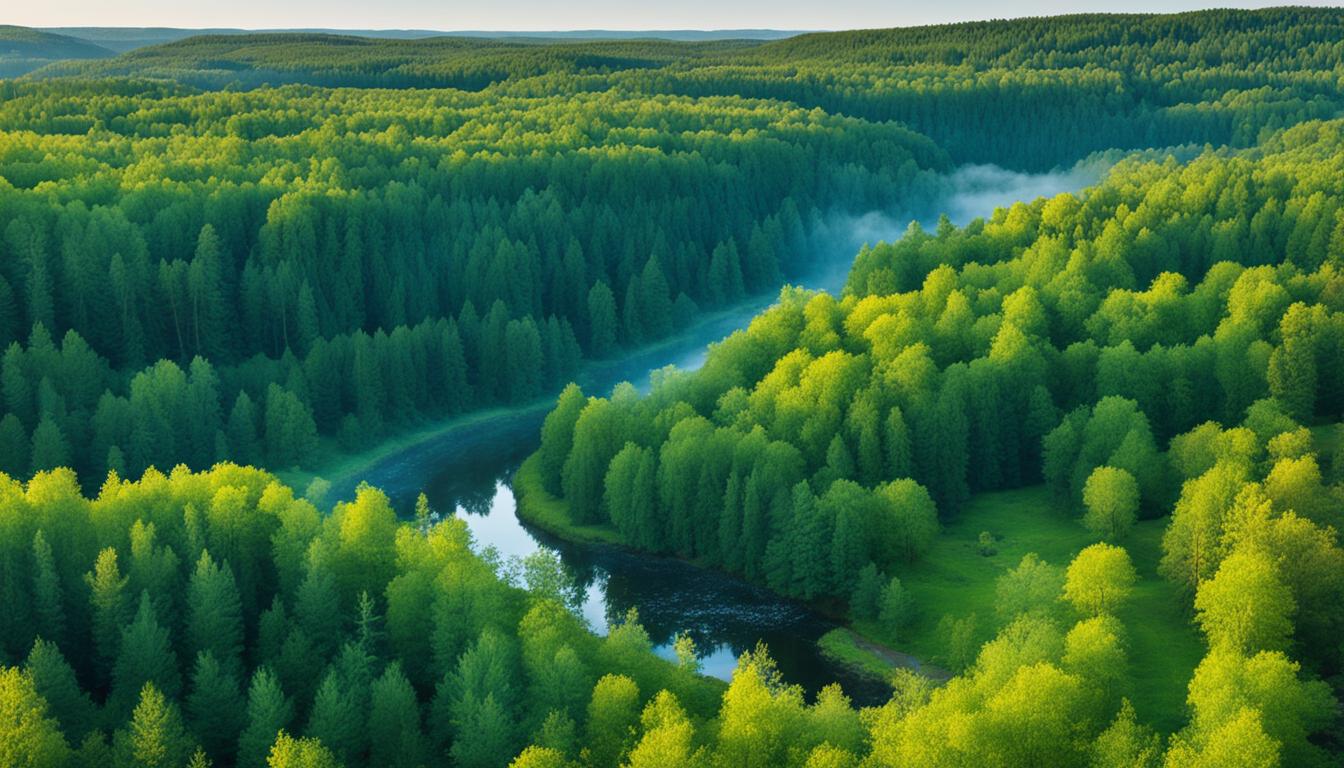


















Post comments (0)